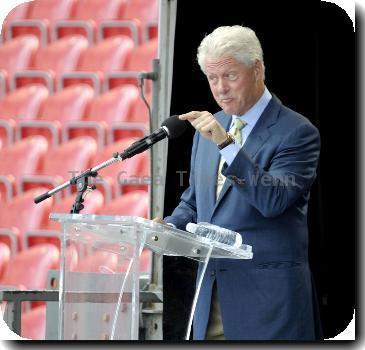An overview of previous US sponsored, Israeli-Palestinian peace talks
By APFriday, August 20, 2010
A look at previous Israeli-Palestinian peace talks
A look at previous rounds of Israeli-Palestinian peace talks and how they fared:
—Sept. 13, 1993, The White House, Washington:
The two sides sign the Oslo accord, negotiated in secret meetings shepherded by Norwegian academics and lower-level officials. The deal includes mutual recognition between Israel and the Palestine Liberation Organization and allows for creation of a Palestinian autonomy government in the West Bank and Gaza. The fate of Jerusalem, Jewish settlements and Palestinian refugees is left for “final status” talks. The historic handshake between Arafat and Israeli Prime Minister Yitzhak Rabin, President Bill Clinton between them, ushers in era of direct peace talks.
—Oct. 15-23, 1998, Wye River Conference Centers, Queenstown, Maryland:
Clinton, Arafat and Israeli Prime Minister Benjamin Netanyahu participate. Israel agrees to hand over an additional 13 percent of the West Bank, bringing Palestinian control to about 40 percent, release Palestinian prisoners and lift trade restrictions. Palestinians agree to arrest militants, give up some guns and annul a clause in their charter that negated Israel’s right to exist. However, Israel releases mostly car thieves instead of political prisoners and Arafat does not reduce forces or confiscate arms.
—July 11-25, 2000, Camp David, Thurmont, Maryland:
Clinton meets with Arafat and Israeli Prime Minister Ehud Barak after the deadline for interim accords expires. Israel offers a Palestinian state in Gaza and most of the West Bank, with a Jerusalem foothold. But disagreements remain, including a demand by Arafat for a right to resettle Palestinian refugees in Israel. The effort fails as fighting erupts two months later and continues for several years, killing thousands in Palestinian suicide bombings in Israeli cities and Israeli military operations in the West Bank and Gaza.
—Jun. 4, 2003, Aqaba, Jordan:
President George W. Bush, Israeli Prime Minister Ariel Sharon, Palestinian President Mahmoud Abbas participate. The parties begin a three-phase process toward a final deal under the internationally backed “road map” peace plan of June 2002. The talks break down because neither side meets their obligations under the first stage: Israel did not halt settlement construction and the Palestinians did not clamp down on militants. A new wave of Palestinian suicide bombings and Israeli targeted killings of Hamas leaders also derails talks.
—Nov. 27, 2007, U.S. Naval Academy, Annapolis, Maryland:
Bush, Secretary of State Condoleezza Rice, Abbas and Israeli Prime Minister Ehud Olmert participate. Direct negotiations resume with the aim of establishing an independent Palestinian state based on the “road map.” Olmert and Abbas hold a long series of direct talks. The last round breaks down in late 2008, reportedly when the sides were close to an agreement. Shortly afterward, Israel launches its bruising military offensive against Hamas rocket launchers in the Gaza Strip.
—May 2010: Indirect, U.S.-mediated talks are launched.
—Aug. 20, 2010: Secretary of State Hillary Rodham Clinton announces resumption of direct peace talks.
Tags: Bill Clinton, District Of Columbia, Gaza Strip, International Agreements, Israel, Jerusalem, Maryland, Middle East, North America, Palestinian Territories, United States, West Bank

